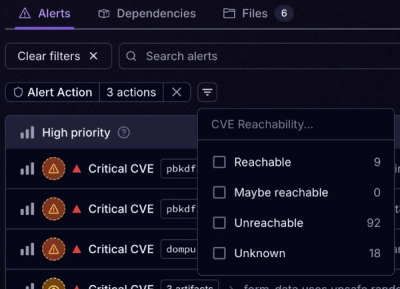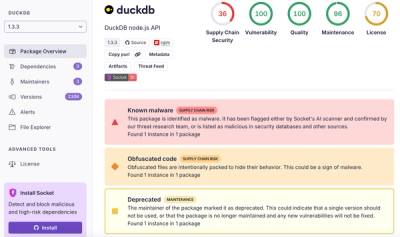
Product
Introducing Tier 1 Reachability: Precision CVE Triage for Enterprise Teams
Socket’s new Tier 1 Reachability filters out up to 80% of irrelevant CVEs, so security teams can focus on the vulnerabilities that matter.
VScroll is a JavaScript library providing virtual scroll engine. Can be seen as a core for platform-specific solutions designed to represent unlimited datasets using virtualization technique. Below is the diagram of how the VScroll engine is being distributed to the end user.

Basically, the consumer layer can be omitted and the end Application developers can use VScroll directly. This repository has a minimal demo page of direct use of the VScroll library in a non-specific environment. There are also several consumer implementations built on top of VScroll:
<script src="https://cdn.jsdelivr.net/npm/vscroll"></script>
<script>
const workflow = new VScroll.Workflow(...);
</script>
npm install vscroll
import { Workflow } from 'vscroll';
const workflow = new Workflow(...);
The main entity distributed via vscroll is the Workflow class. Its instantiating runs the virtual scroll engine.
new Workflow({ consumer, element, datasource, run });
The constructor of the Workflow class requires an argument of the following type:
interface WorkflowParams<ItemData> {
consumer: IPackage;
element: HTMLElement;
datasource: IDatasource<ItemData>;
run: OnDataChanged<ItemData>;
Routines?: RoutinesClassType;
}
This is a TypeScript definition, but speaking of JavaScript, an argument object must contain 4 mandatory and 1 optional fields described below.
A simple data object that provides information about a consumer. It is not critical to omit this, but if the result solution is going to be published as a separate 3d-party library ("consumer"), the name and the version of the result package should be passed as follows:
const consumer = {
name: 'my-vscroll-consumer',
version: 'v1.0.0-alpha.1'
};
An HTML element the Workflow should use as a scrollable part of the viewport. It should be present in DOM before instantiating the Workflow.
const element = document.getElementById('vscroll');
This element should be wrapped with another container with constrained height and overflow scroll/auto. And it also must have two special padding elements marked with special attributes for the virtualization purpose.
<div id="viewport">
<div id="vscroll">
<div data-padding-backward></div>
<div data-padding-forward></div>
</div>
</div>
#viewport {
height: 300px;
overflow-y: scroll;
}
This is a special object, providing dataset items in runtime. There is a separate wiki document describing the Datasource: github.com/dhilt/vscroll/wiki/Datasource. Below is a short version.
The Datasource can be defined in two ways. First, as an object literal:
const datasource = {
get: (index, count, success) => {
const data = [];
for (let i = index; i < index + count; i++) {
data.push({ id: i, text: 'item #' + i });
}
success(data);
}
};
Second, as an instance of Datasource class which can be obtained through a special factory method. Along with the Workflow class, VScroll exposes the makeDatasource method which can be used for creating Datasource class, so the end datasource object can be instantiated via operator new:
import { makeDatasource } from 'vscroll';
const Datasource = makeDatasource();
const datasource = new Datasource({
get: (index, length, success) =>
success(Array.from({ length }).map((_, i) =>
({ id: index + i, text: 'item #' + (index + i) })
))
});
The argument of the Datasource class is the same object literal as in the first case. It has one mandatory field which is the core of the App-Scroller integration: method get. The Workflow requests data via the Datasource.get method in runtime.
For more solid understanding the concept of the Datasource with examples, please, refer to the Datasource doc.
A callback that is called every time the Workflow decides that the UI needs to be changed. Its argument is a list of items to be present in the UI. This is a consumer responsibility to detect changes and display them in the UI.
const run = newItems => {
// assume oldItems contains a list of items that are currently present in the UI
if (!newItems.length && !oldItems.length) {
return;
}
// make newItems to be present in the UI instead of oldItems
processItems(newItems, oldItems);
oldItems = newItems;
};
Each item (in both newItems and oldItems lists) is an instance of the Item class implementing the Item interface, whose props can be used for proper implementation of the run callback:
| Name | Type | Description |
|---|---|---|
| element | HTMLElement | HTML element associated with the item |
| $index | number | Integer index of the item in the Datasource. Correlates with the first argument of the Datasource.get method |
| data | Data | Data (contents) of the item. This is what the Datasource.get passes to the Scroller via success-callback as an array of data-items typed as Data[] |
| invisible | boolean | Flag that determines whether the item should be hidden (if true) or visible (if false) when the run method is called |
| get | () => ItemAdapter<Data> | Shortcut method returning { element, $index, data } object |
Run callback is the most complex and environment-specific part of the vscroll API, which is fully depends on the environment for which the consumer is being created. Framework specific consumer should rely on internal mechanism of the framework to provide runtime DOM modifications.
There are some requirements on how the items should be processed by run call.
run callback is completed, there must be newItems.length elements in the DOM between backward and forward padding elements.oldItems[].element references for this purpose.newItems[].$index comparable to $index of elements that remain: $index must increase continuously and the directions of increase must persist across the run calls. The scroller maintains $index internally, so you only need to properly inject a set of newItems[].element into the DOM.newItems[].invisible attribute can be used to determine whether a given element should be hidden. This requirement can be changed by the Routines class setting (see below).newItems[].$index.A special class allowing to override the default behavior related to the DOM. All DOM-specific operations are implemented as the DOM Routines class methods inside core. When the Routines class setting is passed among the Workflow arguments, it replaces the core Routines. The custom Routines class must extend the core class, which can be taken from the VScroll imports:
import { Routines, Workflow } from 'vscroll';
class CustomRoutines extends Routines { ... }
new Workflow({
consumer, element, datasource, run, // required params
Routines: CustomRoutines
})
The Routines methods description can be taken from the IRoutines interface sources. For example, there is a method that calculates the scroller's offset:
getOffset(): number {
const get = (element: HTMLElement) =>
(this.settings.horizontal ? element.offsetLeft : element.offsetTop) || 0;
return get(this.element) - (!this.settings.window ? get(this.viewport) : 0);
}
If we have a table layout case where we need to specify the offset of the table header, the base method can be overridden as follows:
new Workflow({
consumer, element, datasource, run, // required params
Routines: class extends Routines {
getOffset() {
return document.querySelector('#viewport thead')?.offsetHeight || 0;
}
}
});
It's worth noting that thanks to the extending, we can use parent methods and have access to the correct context after the engine instantiates the Routines:
class CustomRoutines extends Routines {
onInit(...args) {
console.log('Routines settings:', this.settings);
super.onInit(...args);
}
}
Various DOM calculations, setting/getting the scroll position, render process and other logic can be adjusted, improved or completely replaced by custom methods of the Routines class setting.
This repository has a minimal demonstration of the App-consumer implementation considering all of the requirements listed above: https://dhilt.github.io/vscroll/. This is all-in-one HTML demo with vscroll taken from CDN. The source code of the demo is here. The approach is rough and non-optimized, if you are seeking for more general solution for native JavaScript applications, please have a look at vscroll-native project. It is relatively new and has no good documentation, but its source code and its demo may shed light on vscroll usage in no-framework environment.
Another example is ngx-ui-scroll. Before 2021 vscroll was part of ngx-ui-scroll, and its demo page contains well-documented samples that can be used to get an idea on the API and functionality offered by vscroll. The code of the UiScrollComponent clearly demonstrates the Workflow instantiation in the context of Angular. Also, since ngx-ui-scroll is the intermediate layer between vscroll and the end Application, the Datasource is being provided from the outside. Method makeDatasource is used to provide Datasource class to the end Application.
Adapter API is a powerful feature of the vscroll engine allowing to collect the statistics and provide runtime manipulations with the viewport: adding, removing, updating items. This API is very useful when building the real-time interactive applications when data can change over time by not only scrolling (like chats).
Please refer to the ngx-ui-scroll Adapter API doc as it can be applied to vscroll case with only one important difference: vscroll does not have RxJs entities, it has Reactive ones instead. It means, for example, eof$ has no "subscribe" method, but "on":
// ngx-ui-scroll
myDatasource.adapter.bof$.subscribe(value =>
value && console.log('Begin of file is reached')
);
// vscroll
myDatasource.adapter.bof$.on(value =>
value && console.log('Begin of file is reached')
);
Adapter API becomes available as the Datasource.adapter property after the Datasource is instantiated via operator "new". In terms of "vscroll" you need to get a Datasource class by calling the makeDatasource method, then you can instantiate it. makeDatasource accepts 1 argument, which is an Adapter custom configuration. Currently this config can only be used to redefine the just mentioned Adapter reactive props. Here's an example of how simple Reactive props can be overridden with RxJs Subject and BehaviorSubject entities: ui-scroll.datasource.ts.
An important note is that the Adapter getting ready breaks onto 2 parts: instantiation (which is synchronous with the Datasource instantiation) and initialization (which occurs during the Workflow instantiating). Adapter gets all necessary props and methods during the first phase, but they start work only when the second phase is done. Practically this means
Adapter.bufferInfo.minIndex = NaN (because Scroller's Buffer is empty before the very first Datasource.get call),{ immediate: true, success: true, ... }).If there is some logic that could potentially run before the Adapter initialization and you don't want this to happen, the following approach can be applied:
myDatasource = new VScroll.makeDatasource()({...});
myDatasource.adapter.init$.once(() => {
console.log('The Adapter is initialized'); // 2nd output
});
workflow = new VScroll.Workflow({...});
console.log('The Workflow runs'); // 1st output
VScroll will receive its own Adapter API documentation later, but for now please refer to ngx-ui-scroll.
- to Mike Feingold as he started all this story in far 2013,
- to Joshua Toenyes as he transferred ownership to the "vscroll" npm repository which he owned but did not use,
- to all contributors of related repositories (link, link),
- to all donators as their great support does increase motivation.
2025 © Denis Hilt
FAQs
Virtual scroll engine
We found that vscroll demonstrated a healthy version release cadence and project activity because the last version was released less than a year ago. It has 1 open source maintainer collaborating on the project.
Did you know?

Socket for GitHub automatically highlights issues in each pull request and monitors the health of all your open source dependencies. Discover the contents of your packages and block harmful activity before you install or update your dependencies.

Product
Socket’s new Tier 1 Reachability filters out up to 80% of irrelevant CVEs, so security teams can focus on the vulnerabilities that matter.

Research
/Security News
Ongoing npm supply chain attack spreads to DuckDB: multiple packages compromised with the same wallet-drainer malware.

Security News
The MCP Steering Committee has launched the official MCP Registry in preview, a central hub for discovering and publishing MCP servers.